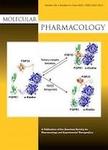版权所有:内蒙古大学图书馆 技术提供:维普资讯• 智图
内蒙古自治区呼和浩特市赛罕区大学西街235号 邮编: 010021

作者机构:Univ Utah Dept Neurol Salt Lake City UT USA Cognetix Inc Salt Lake City UT USA
出 版 物:《MOLECULAR PHARMACOLOGY》 (分子药理学)
年 卷 期:2000年第58卷第3期
页 面:614-623页
核心收录:
学科分类:1007[医学-药学(可授医学、理学学位)] 1006[医学-中西医结合] 100706[医学-药理学] 100602[医学-中西医结合临床] 10[医学]
主 题:结合 竞争性/药物作用 细胞 培养的 芋螺毒素类/药理学 药物相互作用 电生理学 兴奋性氨基酸拮抗剂/药理学 神经元/药物作用 神经元/代谢 聚胺类/药理学 受体 N-甲基-D-天冬氨酸/拮抗剂和抑制剂 转染 光滑爪蟾 动物 小鼠
摘 要:Conantokin G (Con G) is a 17-amino-acid peptide antagonist of N-methyl-D-aspartate (NMDA) receptors isolated from the venom of the marine cone snail, Conus geographus. The mechanism of action of Con G has not been well defined;both competitive and noncompetitive interactions with the NMDA-binding site have been proposed. In this study the mechanism of action and subunit selectivity of Con G was examined in whole-cell voltage-clamp recordings from cultured neurons and in two electrode voltage-clamp recordings from Xenopus oocytes expressing recombinant NMDA receptors. Con G was a potent and selective antagonist of NMDA-evoked currents in murine cortical neurons (IC50 = 480 nM). The slow onset of Con G block could be prevented by coapplication with high concentrations of NMDA or of the competitive antagonist (RS)-3-(2-carboxypiperazine-4-yl)-propyl-1-phosphonic acid. Furthermore, in oocytes expressing NR1a/NR2B receptors, Con G produced a rightward shift in the concentration-response curve for NMDA, providing support for a competitive interaction with the NMDA-binding site. Con G produced an apparent noncompetitive shift in the concentration-response curve for spermine potentiation of NMDA responses, but this was due to spermine-induced enhancement of Con G block. Spermine produced a similar enhancement of DL-2-amino-S-phosphopentanoic acid block. Finally, Con G selectively blocked NMDA receptors containing the NR2B subunit. These results demonstrate that Con G is a subunit-specific competitive antagonist of NMDA receptors. The unique subunit selectivity profile of Con G may explain its favorable in vivo profile compared with nonselective NMDA antagonists.